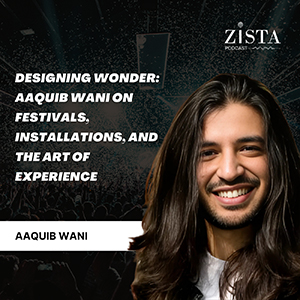Managing Brands in a Web 3.0 Universe
The transition to Web 3.0 is more than just a technological advancement; it’s reshaping the very fabric of our online interactions and brand engagements.
This week on The Zista Podcast, we’re joined by Ipshita Kumar, VP of Brand Innovation at Hype. She sheds light on the nuances of this transformation, how brands can adapt, and what students need to know to be at the forefront.
As we stand on the precipice of a new digital age, this episode offers a clear lens into the future of branding in an ever-evolving digital sphere.
Web 3.0 is more than just a buzzword—it signals a shift in our online world. At its core, it’s about emphasizing user autonomy, decentralization, and the power of blockchain technology.
This episode of The Zista Podcast welcomes Ipshita Kumar, a marketing professional deeply involved in this transformative space. As the VP of Brand Innovation at Hype, Ipshita provides real-world insights into how brands are navigating and benefiting from this change.
In her role, she’s been instrumental in guiding brands through the maze of the metaverse, tapping into the endless possibilities of Web3 and NFTs. Through our conversation, Ipshita sheds light on how innovative brands are leveraging the prowess of Web3 technologies to offer unparalleled value to their audiences.
For those on the cusp of exploring this dynamic landscape, Ipshita’s insights serve as a compass. She unveils the competencies and mindsets that brands ought to embrace to remain at the forefront in this decentralized age.
Additionally, for those eager to deepen their understanding of Web 3.0, she offers her recommendations on must-visit resources and platforms. Her recently launched course, “Make Waves in Web3,” exemplifies her commitment to sharing knowledge, especially for women eager to decode the intricacies of this digital evolution.
From curious beginners to industry experts, this episode offers insights into the complexities of branding in the Web 3.0 universe for all who are interested in the digital frontier.
KEY TAKEAWAYS
- Legacy brands are beginning to recognize the potential of the Web3 space and need guidance to innovate and immerse themselves in this new digital realm effectively.
- In the fast-paced world of Web3, brands don’t need to dive headfirst into every trend. It’s essential to understand a brand’s core identity and determine which Web3 tools align with its ethos.
- NFTs can enhance real-world experiences. For instance, brands sponsoring events can provide redeemable NFTs, bridging virtual and physical engagements.
- Given the complexity of the Web3 space, educational courses and programs aimed at demystifying it can be invaluable, emphasizing the importance of continuous learning.
- As the importance of Web3 grows, new specialized roles like Web3 Lead or Metaverse Manager are emerging, indicating the increasing integration of this technology into mainstream business structures.
QUESTIONS
Q1. How can brands recalibrate their approach and immerse themselves in the metaverse through Web3 and NFT?
A: Ipshita joined HYPE towards the end of 2021 when the NFT landscape was booming. Although HYPE had been a market leader for five years and was recognized as the premier creative marketing agency for the top 100 crypto projects, they hadn’t ventured into NFT marketing services. Her primary responsibility was to harness the vast creative expertise HYPE possessed and channel it into a new service offering: NFT marketing.
Within just half a year, she recognized that NFTs were merely a fraction of the broader emerging tech ecosystem. This ecosystem encompasses the metaverse, the gaming sector, and the pre-existing technologies of AR and VR. In essence, when you consider them collectively, they represent the future of tech.
Ipshita observed leading brands like Nike, Adidas, Louis Vutton and Gucci venturing into Web3, leading to a pivotal realization: conventional brands are beginning to grasp the potential of this space and are making their mark in Web3 in some truly innovative ways. This insight spurred her to broaden the horizon to encompass the entirety of emerging tech.
The goal was to devise strategies to aid traditional brands in their transition to Web3 or to embrace emerging technologies. This evolution would strengthen their connection with consumers, whether that’s through gaming, in-store AR/VR experiences, or NFTs.
At HYPE, Ipshita’s mission has always been clear: demystify the complexities of this new digital realm for brands. She aims to translate the technical jargon into terms brands are familiar with. So, whether a brand aims to launch a product, initiate a campaign, or tap into the potential of this new tech, Ipshita and her team at HYPE are there to guide them – from the initial concept to its full execution.
Q2. How are brands harnessing Web3 technologies, including blockchain, NFTs, AI, and decentralized platforms, to enhance value for consumers and stakeholders?
Ipshita places a spotlight on the concept of ‘value’ in brand outreach. She points out that while many brands and marketers strive to innovate, they sometimes lose sight of the central goal: generating value for the end consumer.
Recalling the emergence of e-commerce, Ipshita draws a parallel with the initial hesitation industries like alcohol and perfumes, faced. There was skepticism about selling products that traditionally depended on sensory experiences, like taste or smell, online. Yet today, e-commerce is an integral part of nearly every brand’s strategy.
In the present digital metamorphosis, Web3 emerges as a revolutionary avenue for brands.
Blockchain offers transparent and traceable transactions. This is particularly crucial in industries like luxury spirits and fashion where authenticity is of utmost importance. An illustrative initiative here is the Aura Consortium, comprising luxury giants like Prada, LVMH, Cartier, and Mercedes-Benz. They’ve championed a blockchain solution tailored for luxury brands. For instance, a Louis Vuitton diamond purchase is securely documented on the Aura Blockchain, assuring its genuineness.
NFTs (Non-Fungible Tokens) are increasingly being recognized by brands as tools for authenticity and value assurance. BlockBar’s NFT marketplace stands out in this context. Here, luxury spirits are represented as NFTs, with each purchase signifying ownership of both the digital token and the corresponding spirit bottle. Beyond the transaction, BlockBar further elevates customer experience by offering specialized storage solutions, allowing patrons to store their premium spirits under optimal conditions until they choose to consume them.
In the gaming realm, platforms like Roblox and Fortnite are observed as potential brand engagement hotspots. Recognizing the extensive user base of these platforms, which extends beyond teenagers to young adults, brands are exploring virtual integration. An illustrative example is a brand, hypothetically like H&M, creating an in-game store within Roblox. Gamers might engage in activities and quests, eventually earning real-world rewards such as redeemable coupons, which can be used in physical stores.
The synergy of event sponsorship and NFTs is another innovative avenue. When brands, like Bacardi or Budweiser, sponsor global phenomena like Coachella, they can augment the experience by offering redeemable NFTs. Such strategies seamlessly meld the virtual and physical worlds, exemplifying how brands can leverage technology to offer tangible value.
In Ipshita’s perspective, these instances clearly depict that Web3 technologies empower brands to cultivate direct, meaningful relationships with consumers, ensuring transparent and traceable value delivery.
Q3. How should brands strategize for a Web3-driven future to ensure competitive advantage? What specific skills, capabilities, and mindset shifts are vital for their evolution?A: Ipshita emphasizes that while a multitude of brands currently harness the capabilities of Web3, she envisions a not-so-distant future where its adoption becomes universal. The trajectory to this future, according to her, is deeply rooted in brands’ willingness to innovate and experiment.
She recounts that often brand managers may be hesitant, given the myriad stories surrounding cryptocurrency-related losses or apprehensions about the financial implications of constructing their own metaverse. However, the key lies in understanding the brand’s core identity and then discerning which Web3 tools align with its ethos. Not every brand necessarily needs a metaverse or an NFT initiative.
Illustrating this point, Ipshita cites the approach of the renowned brand, Tiffany. Instead of diving headfirst into launching their own collection or a grand metaverse activation, Tiffany cleverly collaborated with a high-value NFT collection. The result? A digital rendition of Tiffany’s signature pendant that synced perfectly with the brand’s elegance, all without embarking on a separate NFT strategy.
Brands, she believes, should be guided by a spirit of experimentation, a laser focus on the value they offer, and an unquenchable thirst for learning. The world of Web3 is an emerging realm, reminiscent of the times when the adoption of platforms like Instagram by brands was still in its infancy. Fast forward to today, and even elite brands and major sports clubs, such as Manchester United and Liverpool, are recruiting specialists in roles like Web3 Lead or Metaverse Manager. This proactive approach is a testament to the increasing recognition of Web3’s potential.
However, Ipshita also notes a significant number of brands are yet to harness this technological suite, indicating both the opportunities and challenges that lie ahead in the world of brand evolution and Web3.
Q4. Ipshita recently rolled out a LinkedIn short course titled “Make waves in Web3”, designed to guide businesses in their Web3 journey. What motivated her to introduce this particular course?
A: Ipshita explains that her inspiration for this course stemmed from the encouragement and support of Allbright Collective, an organization based in London that serves as a guiding force for women founders. The collective had already initiated a partnership with Ripple, a forerunner in providing crypto solutions to businesses. Their collaboration aimed to roll out brief, yet comprehensive, learning modules which were freely accessible to all. The primary objective? To facilitate a smooth transition for numerous women into the realm of Web3.
She stresses that the world of Web3, laden with industry-specific jargon, can seem overwhelming and exclusive. By eliminating these barriers, the intention was to democratize knowledge and make the space more approachable. Given Ipshita’s day-to-day role of demystifying Web3 for brands, this collaboration was a logical next step for her.
The overarching mission is broader than just introducing more women to Web3. It is about fostering inclusivity in a sector that currently sees a significant gender disparity. Especially considering the limited representation of women, and even more so for Indian women in Web3, there’s a pressing need to pave the way for more diverse participation.
Q5. Given the nascent stage of Web 3.0, which resources and platforms can budding enthusiasts explore to deepen their understanding and hone their expertise?
A: Ipshita emphasizes that the realm of Web 3.0 is still in its initial phases, meaning there isn’t a definitive textbook or academic expert who can impart everything there is to know. However, the silver lining in today’s digital age is the plethora of freely available learning resources, from platforms like YouTube and TikTok to a myriad of educational influencers creating digestible content for diverse platforms, including meta-platforms.
That said, Ipshita cautions learners to be discerning. The ease of access to information means misinformation can proliferate just as quickly. Her trusted method? Keeping tabs on the leading figures actively engaged in Web3. By subscribing to their podcasts or newsletters, she gathers insights directly from those at the forefront of the evolution. She personally leans more towards reading and listening rather than visual content.
To weed out potential misinformation, she suggests distinguishing between those genuinely building in the Web3 space, from those merely discussing it without much hands-on experience. Her advice for learners is to curate their sources based on their domain: engineers should follow pioneering engineers or CTOs in Web3; marketers should track experts in Web3 marketing; and for those in product development, turning to those who are actually creating in the space can prove invaluable.
These thought leaders, especially those from renowned Web3 firms or organizations, frequently share educational content across platforms like LinkedIn, Twitter, or their personal newsletters. In contrast, Ipshita advises skepticism towards individuals who may flaunt vast earnings or have dubious follower counts. Understanding the genuine intent behind such content is crucial to ensuring authentic and valuable learning.
Q6. How did Ipshita’s diverse background pave the way for her journey into Web3?
A: Ipshita believes her foundation in hospitality has been pivotal in molding her career path. Her academic pursuits led her to Les Roches Marbella, an international institution, where she initially observed a noticeable absence of fellow Indians. Over time, although more Indian students did join, her initial experiences instilled in her the value of stepping out of her comfort zone. Being surrounded by Europeans, who differed in language, beliefs, and upbringing, she recognized the importance of bridging gaps and forging connections.
This adaptability further manifested during her internships. These experiences were not just about mastering the tasks at hand; they were about navigating real-life challenges, managing finances, and adjusting to diverse work cultures. Her tenure at the Renaissance in Barcelona was a pivotal moment. It was there that she recognized the juxtaposition of an increasingly tech-driven world with an industry – hospitality – that was lagging behind. In her personal life, she enjoyed the conveniences of Zomato for food and Uber for transport, yet observed a tech shortfall in her professional realm.
This realization drove her to pivot towards emerging technologies. She aspired not just to immerse herself in this new domain but to bridge the gap between tech and hospitality. Today, she sees the fruition of her vision. Having already collaborated with three F&B brands on their Web3 initiatives this year, she feels a deep sense of accomplishment. For Ipshita, it’s more than just professional success; it’s about bringing her expertise full circle back to where she began.




